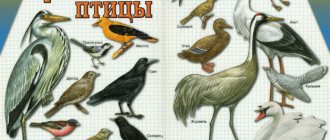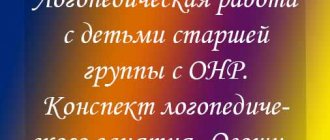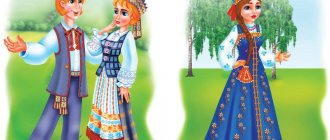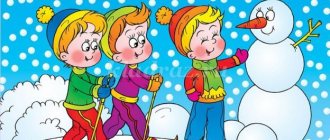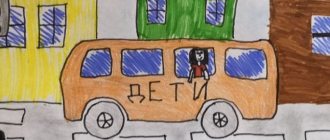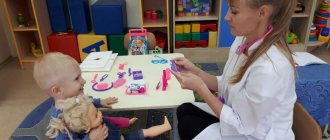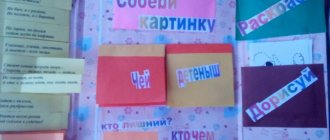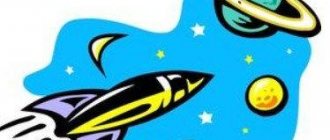Homework on the lexical topic: “Our region.” Our city" - senior speech therapy group
Our region. Our street.
Conversation: −
look at illustrations, photographs and postcards depicting our Land, what is it rich in?;
- ask the child the name of the city in which he lives, the street on which his house is located;
- Pay the child’s attention to what the city is named after, what it is famous for, tell us about the most important events that happened in our city, what attractions it has;
- “Select a sign and an action”
Region (which?) - polar, northern, native, rich,...
The city (which one?) is clean, bright, noisy, cheerful, snowy,...
Street (what?) – long, quiet, narrow, green,...
The townspeople (what are they doing?) - building, cleaning, repairing, having fun, decorating,...
- "Name it after example"
street - street
–
no streets
city –
town
–
no town
shop – shop
–
no shop
bridge –
bridge
–
no bridge
courtyard – courtyard
–
no yard
address –
address
–
no address
flashlight – flashlight – no flashlight
road
– path – no path
- "Count 2.5"
One green square two green squares five green squares
One tall building two tall buildings five tall buildings
One city pharmacy two city pharmacies five city pharmacies
One large area two large areas five large areas
One football field two football fields five football fields
- "Say it with the word 'urban'"
transport – city transport
apartment –
city apartment
houses – city houses
park -
city park
streets - city streets
theater –
city theater
post office – city post office
building -
city building
school - city school
station -
city station
residents - city residents
church -
city church
- Complete the sentences by changing the word WENT,
consolidating the skills of using prefixed verbs
Sasha to the house... (approached)
The boy across the road
...(crossed)
He entered the entrance ...(entered)
Over the bridge
...(crossed)
Sasha quickly left the entrance ...(went out)
Sasha to the park
...(reached)
From the house ...(moved away)
He went around the tree
...(walked around)
Our town
- Parents are recommended:
- remember with your child the name of the city in which he lives, the street on which his house is located, name the main street of the city;
- pay attention to what the city is named after, what it is famous for, tell about the most important events that happened in your city, what attractions it has;
— look at illustrations, postcards and photographs depicting your city;
- repeat with the child the home address, the address of the kindergarten;
¾ attitude towards your city and your street;
¾ why do you need to know your address?;
¾ Who can you tell your address and who can’t?
- remind you of the need to follow traffic rules.
- Didactic game “Name which one”
(formation of complex words):
house (what?) - multi-story, one-story, apartment.
3.
Didactic game “One - Many” (formation of the genitive plural of a noun)
:
one house - many houses, one street... (village, city...).
4.
Exercise in word formation using suffixes .
House - house, house, house.
City - town, town, settlement.
5.
Didactic game “Pick a sign”:
street (which one?) - quiet, noisy, narrow, wide, green
city (which?) - ..., house (which?) - .... apartment (what?)¾…
6.
Didactic game “Here and There”
Here is a house, and there are houses; here is a street, and there is ¾ ...; here is a store, and there is ¾...;
here is a pharmacy, and there is ¾ ...; here the area, and there ¾...; here is a flowerbed, and there is ¾...;
7.
Exercise in forming the plural of nouns
“Count 2, 5”
One square, 2..., 5...; One street, 2..., 5...; One house,… 2.., 5…
8.
Compose the story
“The House Where I Live” (child’s free story).
9.
We teach the child
to clearly pronounce words and phrases: traffic controller, sidewalk, policeman, traffic rules.
MAGAZINE Preschooler.RF
THEMED GAME “MY CITY”One of the most important and striking traits of preschoolers is curiosity. Children constantly ask questions and want answers right away. If adults cannot or do not want to explain to children what interests them, their curiosity disappears. Therefore, the only option for introducing children to the world around them is to learn how to answer any questions children may have.
In early preschool age, all the child’s activities are subordinated to one leading need - knowledge of the world around him and himself in it. The main means of satisfying this need still continues to be the sensory (sensual) development of reality through sensations, sensory perceptions, and visual representations. But at this age the thresholds of sensations begin to decrease. This is compensated by an increase in visual acuity and accuracy in distinguishing colors, development of hearing, and accuracy in estimating the weight of objects.
The most characteristic actions are those that allow the child to examine objects, highlight their most typical properties - to separate and combine sensations, giving them the characteristics of sensory standards, generally accepted patterns of perception. Such activity lays the foundation for the transition to a higher stage of development - from visual-effective to imaginative thinking. Rhythm and clarity become the most important conditions for the development of normal perception and comprehension of what is perceived.
It is very important during this period to teach children to name their hometown (village). Encourage them to talk about where they walked on weekends (in a park, square, children's playground, in the country). Pay attention to buildings and remember the streets along which children walk from home to kindergarten, what attractions there are in their hometown, what rivers or even seas are nearby.
To get acquainted with the city, to expand knowledge about the world around us, and to develop communication skills, I offer the game “My City” .
"MY CITY"
Goal: Expanding children's knowledge about the world around them, developing children's communication skills. Forming an idea of classification based on characteristics.
Age: 3-8 years
Number of players: group of children 10-12 people
Necessary equipment: “city” , with marked streets. Sets of geometric shapes (circle, square, triangle, rectangle), primary colors. A set of rectangles with the name of administrative buildings: school, kindergarten, pharmacy, post office, hospital, cafe, store, etc.
Game description: At the beginning of the game, the presenter reads a poem for finger gymnastics “My City” .
I love walking around the city! (They walk with their fingers on their knees) I like to watch, (Turns the head left and right)
I love counting! (clench - unclench their fists) Streets - once! (Bend fingers one at a time)
Area – two! Park - three! And four - I live in an apartment! Five - I'm walking in the park again!
Six - I’ll go to Belaya and look at the water! Seven – “Nalmes” , Palace of Culture, Beautiful and huge,
And it is located in the center! Eight - New Year's tree! Nine - I came across the Great War Monument...
Ten is our cinema! I will go around all of Maykop! (They walk with their fingers on their knees) I love the city very much!
(Clench and unclench their fists)
Children remember and name administrative buildings and stick them in random order on the playing field. Then they place the house figures according to the names of the streets. For example: on VESENNYA (the color with which spring is associated) there can be houses of various shapes, but only green. On the street "MORSKOY" - blue (light blue). And on the street of “MULTI-COLORED SQUARES” there are only squares, but of different colors, etc.
When the city is built, you can proceed to the next stage of the game. Each participant chooses a “house” where he “lives” and gives it a number (you can write it on a figure). A preliminary conversation is held “Where do I live?” . Children name their street and house or apartment number. Then the adult starts the game: “Katya needs to go to the store. What is the best way for her to get through? Children “pave” the way to the desired building, while naming which streets they need to go through and past which buildings. Every child should be a leader. That. children explore the city, learn to navigate the area, and expand their knowledge about aspects of public life.
Play is the most progressive method of teaching preschoolers. It is through play that a child’s abilities such as intelligence, resourcefulness, the ability to think logically, compare and remember are more easily formed. Play makes the learning process less tedious and much more effective.
| Next > |
Game quiz “My city Rostov-on-Don”
Scenario for a game quiz dedicated to
272nd anniversary of the founding
city of Rostov-on-Don
“My city Rostov-on-Don”
Target.
Summarize the knowledge of preschoolers about their hometown, about their small Motherland.
Tasks:
— create conditions for generalizing, systematizing and expanding children’s ideas about their hometown;
— develop the ability to recognize architectural monuments and historical places of the city;
- develop creative imagination, associative memory;
- develop curiosity and attentiveness;
- cultivate a sense of mutual assistance;
- cultivate love for the Fatherland.
Form:
quiz game, competition, 2 teams participate.
Materials
: presentation about the city, photographs with views of Rostov-on-Don, city coat of arms and flag, bag of chips, 2 bells.
Quiz progress:
All students are divided into two teams; for this, before the start of the quiz, the guys choose squares from a magic bag: blue, red.
Teacher:
Guys, today our quiz lesson is dedicated to the 272nd anniversary of the founding of the city of Rostov-on-Don. And a quiz dedicated to our city will show who knows the city better, its interesting places and attractions.
We have already divided into two teams, and now each team must choose a captain (time is given).
Teacher:
The captain of each team must introduce the team and say its name.
Teacher:
Correct answers are counted based on the chips received by each team, which we will put in the captains' baskets.
Teacher:
And now the guys have prepared poems about our city. Let's listen
- In the vast expanses of the Don Sails of clouds glide. Since childhood, our affectionate city of Rostov has been dear to us, like our Motherland.
- Rostov is not a name, not a word. He is our hearts and years. Planes are flying to Rostov, trains are rushing to Rostov.
- Rostov-on-Don you are powerful and stern, For centuries you have been carrying a stern bolt, And people wander through your squares, And you tell them, I will give peace to the world!
Teacher:
before the quiz, let's take a trip to our hometown
“I love my city!” — video trip around the city of Rostov-on-Don.
Teacher:
I announce the start of the quiz. The team is given 1 minute to think about the question, after which the team must ring the bell; the team that gives the signal first wins.
Questions:
- Name the main square of our city (Theater Square)
Teacher:
In the 1920s - the first half of the 1930s,
the square
was called
Square
.
After the construction of the theater building, the square
changed its name to
Teatralnaya
.
2. Name the main street of Rostov (B. Sadovaya)
3. Tell what is on the main street of the city (Southern Federal University, M. Gorky Theater, Revolution Park, M. Gorky Park, musical theater, philharmonic society).
4. Name what nationalities live in our city.
5. Name what weapons the Cossacks used when they defended their land from the enemy.
6. What did the Cossacks use to carry water?
Outdoor game “Carry the water.”
Children use a large spoon to transfer water and fill the bucket.
7. Where do fairy tales live in Rostov-on-Don? (Puppet theater and Youth theater, musical theater, M. Gorky theater)
8. What city transport do you know?
Outdoor game "Transport"
The game is played on easels - you need to assemble a bus or tram from parts of a car.
8. Which train stations of the city of Rostov do you know?
9. Find out from photographs and name places in Rostov.
Teacher
: The monument to Grandfather Shchukar, erected in the fall of 1981, is dedicated to the character of the literary work “Virgin Soil Upturned” by M.A. Sholokhov.
Teacher
: Where is he located? (It is located on the city embankment - on the corner of Semashko Avenue and Beregovaya Street.)
Teacher
: A huge iron machine sits proudly on a high pedestal. Indeed, the combine harvester is a worthy source of pride - its invention in the post-war years was the only salvation for the starving population of the country.
Nowadays, Rostselmash Vector combines are being successfully modernized and are actively used for harvesting in all corners of Russia.
Teacher
: Where is he located? (Opposite the monumental building of the Rostselmash Palace of Culture rises an equally colorful monument - the Rostselmash Vector combine harvester.)
Teacher
: Trade Righteously - You Will Make Profits! reads the inscription on the box of this inhabitant of the southern capital. A satisfied-looking merchant is waiting for you on Bolshaya Sadovaya Street. The cat looks at him trustingly, arousing no less interest among Rostovites and guests of the city. The monument is often called simply “Merchant with a Cat.”
The monument has been decorating the city since 2006. Its creator is sculptor Dmitry Lyndin.
The merchant-peddler is one of the symbols of the rapidly developing Rostov-on-Don. Plus, he knows how to make wishes come true! The residents came up with a whole ritual: you need to rub the merchant’s caftan, put a coin in his bag-box, pet the cat and, finally, make a wish by holding the thumb of the figure’s left hand.
10. What is the most important thing for a peaceful, happy life for all people? (friendship, peace)
Children read poems about friendship, about peace, about their hometown.
Teacher:
Let's sum up the results of the quiz, let's count the chips in the captains' baskets.
Award ceremony.
"Outdoor games on lexical topics"
Thematic week: “Our kindergarten”.
Outdoor game: “We are funny guys.”
Lines are drawn on two opposite sides of the site, and several circles are drawn on the side. This is the driver's house. The players gather behind the line on one side of the court and say in chorus:
We, funny guys, love to run and jump.
Well, try to catch us! One, two, three, catch us!
After the word “catch!” everyone runs to the opposite side of the site. The driver must catch one of the runners before he crosses the second line. The caught person stands in a circle - the driver's house. Then the children read the poems again and run across the playground in the opposite direction. After 2-3 attempts, they count how many children are caught, choose a new driver and the game continues.
Thematic week: “How bread came to the table”
Relay race: “Combine operators”.
Let's imagine that we are in a field, and wheat is growing on it, and we are combine harvesters. Look, our wheat has grown. And the combine operators need to collect it and put it into the truck (toys). There is wheat in the hoop (field) - children take turns running up with a spoon, scooping grains from the pile and taking them to the car (toy). Who will collect the most grains?
Relay race: “Transport the grain.”
While the combine operators were transporting, they scattered the grains along the road. Now we will all collect the grains together and take them to the mill to make flour. The grains are scattered on the floor in a hoop in one common pile. The children, while the music is playing, all run up together and pick up grain from the common pile and take it to their “mill”.
Thematic week: “My City”
Outdoor game: “Favorite City.”
The participants of the game are located in one “city”. There's a trap in the center. The goal is to run to another city without freezing. Whoever ran to his favorite city without freezing won.
Thematic week: “Toys”.
Outdoor game: “who is most likely to take the toy”
Children move in a circle in a column one at a time to rhythmic music. In the center of the circle is a doll in a hoop. On command, children perform imitative movements (we walk like dolls, we walk like bears, we jump like parsleys). The music stops playing, the children run to the center of the hall to the doll. Whoever touches the fastest is the winner.
Low mobility game: “find and remain silent”
The children turn away, the teacher hides the toy. Children begin to look for a toy, the one who found it approaches the teacher and speaks in his ear where it lies.
Thematic week: “Clothing”.
Relay race: “Washing”.
Children are divided into two teams. A rope with clothespins is stretched near the teams. At the opposite end of the hall there are two basins with clothes. The task of the teams is to run to the basin, take the clothes, run to the rope and hang them on the rope. Whose team is faster?
Quiz for children of the preparatory group of kindergarten. My city
Quiz for children 6-7 years old “My country.
My land. My city. My street" Purpose: Testing and activating children's knowledge and independent judgments about the country, native land and city. Objectives: • consolidate children's knowledge about our country, native land and city; • systematize children's knowledge about the symbols of the state: flag, coat of arms, anthem. • expand children's horizons; learn to answer questions depending on the content, using an accurate, expressive vocabulary; • to cultivate in children patriotic feelings, respect for all nationalities, love and respect for Russia. Materials and equipment: - laptop, multimedia projector, multimedia presentation; - images of parts of the house (30 pieces), envelopes with cut parts of sayings and proverbs about the Motherland, an envelope with parts of the Russian flag, an envelope with different images of the coat of arms of Russia, sound fragments of anthems, images of cultural symbols of Russia (matryoshka, Dymkovo toy, accordion), 9 scarves, folk instruments (spoons, metallophones, whistles), 3 album sheets of paper, 3 packs of felt-tip pens. Musical material used in the game “Pilots”: Idea, selection of music, mix - Kholodnaya I.V.
“Kangaroo dot, ru” by Zhanna Kolmagorova “Song about penguins” lyrics by A. Gorokhov, music by V. Kuprevich “Turtle” Music by A. Varlamov. Words by R. Panina “Dolphins” music. A. Varlamov “Merry monkeys” Y. Seliverstov “Good mood” lyrics. Natalya Ososhnik, music Vitaly Ososhnik Preparatory work: implementation of a child-adult project (with the participation of parents) - the books “Streets of my city”, “Professions of my parents”; exhibitions in the groups “Folk Crafts of the Urals”, “Treasures of the Urals” (exhibition of stones), “Sights of the City of Serov”; exhibition of books by writers and poets of the city of Serov; reading tales by P.P. Bazhov, exhibition of drawings and creative works “My City”, acquaintance with national customs (holiday “Svyatki”). Progress of activities
To the music of the song “My Russia” (G. Struve), children enter the hall and sit down at tables in subgroups.
The leading ball is large, there is a country on it, a city in it, and houses in it. The house is on one street, inconspicuous, small. This house, country, land - This is my Motherland! Presenter Today we have gathered, guys, to tell each other what we have learned about our homeland, our region, our city. You have to answer 10 questions and complete 10 tasks. You are divided into groups. Each group's responses will be scored. For each correct answer and correctly completed task, the team receives a part of the house, from which we will later make up a city. The better and more correct your answers are, the higher and more beautiful your houses will be. Who wants to build the tallest and most beautiful house? (children's answers)
Host Of course, you all want this. Then let's get to work! Attention, this is the first question of our quiz. 1. What is the name of the country in which we live? (Russia) Assignment to teams: Make up sayings and proverbs about our Motherland from parts (adults work in teams and read parts of proverbs to children). Team 1 - Beloved homeland, like a dear mother. Take care of your native land like your beloved mother. Team 2 – On someone else’s side, even spring is not beautiful. If friendship is great, the Motherland will be strong. Team 3 – A man without a homeland is like a nightingale without a song. The Motherland is your mother, know how to stand up for her. Leader Teams that correctly complete the task receive the first floor of the house. Presenter Attention, this is the second question of our quiz. 2. Name the state symbols of Russia (Coat of Arms, flag, anthem) Practical task: 1 team - collect the flag of Russia 2 team - determine in which fragment the Russian anthem sounds 3 team - Game “Find the differences” (different images of the coat of arms of Russia). Russia has a majestic double-headed eagle on its coat of arms, so that He could look to the west and east at once. He is strong, wise and proud. He is Russia's free spirit. (V. Stepanov) Presenter Teams that correctly complete the task receive the second floor of the house. Presenter Attention, this is the third question of our quiz. You discuss the answers as a team, one of the participants comes out and pronounces it. 3. Who is the head of the Russian state? (President) One of the team members is invited. Participants voice their teams' answers. Demonstration of photos by V.V. Putin on a presentation slide. Leader Teams that correctly complete the task receive the third floor of the house. Presenter Attention, this is the fourth question of our quiz. 4. Every country has a main city - the capital. What is the name of the capital of our homeland? (The capital of Russia is Moscow.)
Practical task: explain the meaning of expressions. The participants are conferring. One of the team members comes out and voices the team's answer. Team 1 - Why do they say “Moscow is the heart of Russia”? Team 2 - How can you understand the words: “They say it in Moscow, but they listen all over the country?” Team 3 - How can you understand the words: “She is the head of all cities, the capital of the Motherland is Moscow.” Leader Teams that correctly complete the task receive the fourth floor of the house. Presenter Attention, this is the fifth question of our quiz. Rus' has long been famous for its craftsmen. Child The stone-cutting craftsmen are famous, the Keepers of the magic fire, the steel and iron minters - Russia is a famous family. 5. “Who will draw and name the symbol of Russia more accurately?” Each team lines up. Teachers show each of their teams an image for 20 seconds. and remove it. Children sit down at the tables. On a sheet of paper, they take turns sketching what they managed to remember, then pass the sheet to another team member. Upon completion of the work, one team member comes out and demonstrates the resulting image and names the symbol of Russia. Leader Teams that correctly complete the task receive the fifth floor of the house. Presenter Attention, this is the sixth question of our quiz. Among the expanses of our great Motherland there is a corner where you live, where is your home, your native land. And wherever you are, wherever you go, you will always remember your native place, your home, your parents and friends. 6. What is the name of our native land? (Ural) Brave and skillful people lived in the Urals. After a hard day at work we played various musical instruments. Our ancestors knew how to work and relax with soul. Child Sonorous, carved, painted spoons From dawn to dawn the spooners play for us. And we are brave guys, skilled in all matters. We'll take the instruments and start the orchestra.
Assignment to the team: Listen to a sound fragment and play it on folk instruments. It is determined whose team will perform the melody more accurately and amicably. Leader Teams that correctly complete the task receive the sixth floor of the house. Presenter Attention, this is the seventh question of our quiz. 7. What were the names of the first inhabitants of the Urals? (Khanty and Mansi)
The Khanty and Mansi lived in tents. Game “Who can build a tent faster” (children use large scarves to build a tent, which team is faster)
Leader Teams that correctly complete the task receive the seventh floor of the house. Presenter Attention, this is the eighth question of our quiz. 8. Now we live in beautiful cities, in cozy houses. Whose name does our city bear? (pilot Anatoly Konstantinovich Serov)
Child He lifts a metal bird into the clouds. Our air border is reliable and strong. Presenter What do you think pilots should be like? Children speak out (strong, resilient, dexterous) Presenter Let's see if you can show courage and dexterity. Game "Airplane". Rules of the game. Children are divided into groups of 3 people. Each group is a squad of pilots. Every child is an airplane. Airplanes are in hangars. Hangars are located in any way: in a circle, in a line, in a column, etc. Each pilot must remember the location of his hangar in order to return exactly to it. At the signal, the pilots fly: arms to the sides, movement in any direction. Condition: do not bend your arms (considered a broken wing). If you encounter another plane, you can “plan”: lean to the right, left, forward, but do not bend your arms. At the signal, the pilots return to the hangars.
The game takes place with sound accompaniment.
Children listen to the announcer and perform the suggested actions: 1. “Pilots, to the airfield!”
Children sit down 2. “Let’s start the engines!” Children sitting (a prerequisite for alternating motor activity and rest) make a “winder” with bent arms. 3. “Take flight!” Children pretend to fly an airplane (fly) 4. “Attention, landing!” Children squat down. 5. Next, imitative movements of the animals of those countries and continents where the planes arrive are performed. Presenter We return to our city. Attention, landing! The children take their places at the tables. Leader Teams that successfully complete the task receive the eighth floor of the house. Presenter Attention, this is the ninth question of our quiz. 9. Game “Guess what I wished for” Images of various sights of the city of Serov are shown to the children. The presenter makes a wish for one of them. Children must guess what landmark he wished for by asking any questions except a direct question about the name. A set of images for team 1: - the city administration building - an anniversary stone for the city’s centenary. A set of images for team 2: - the building of the metallurgists’ palace of culture - “The Wishing Stone” at the library named after. D.N. Mamin-Sibiryak Set of images for team 3: - Temple of the Transfiguration of the Lord - Memorial "Eternal Flame" Leader Teams that successfully complete the task receive the ninth floor of the house. Presenter Attention, this is the tenth and final question of our quiz. 10. There are many streets and squares in our city. On what street is our kindergarten located? Why is this street called Green? (children's answers)
Leader Teams that successfully complete the task receive the tenth floor of the house. Presenter Our children, together with their parents, prepared the book “Streets of Our City”. Demonstration of the book and children's stories about the streets. Leading. - You guys are great, you know a lot about your Motherland, you love it and its nature, you respect your family and friends, you know your land. I invite each team to create their own house from the floors they receive. Approach with invention, imagination. Create your own unusual home. Leading. What wonderful houses you have turned out to be. Let's look at each other's houses. Children walk in a circle, looking at the houses of other teams.
Leading. Guys, look, there are empty windows in our houses. Let's light some lights in them. - Evaluate your work. Use felt-tip pens to color the windows of the house like this: • green light - he didn’t make a single mistake, he always knew the answer, he’s happy with himself; • yellow light – made an inaccuracy, did not always know the answer; • red light - I still need to learn a lot, I need to try and success will come. Houses with lit lights are located on a stylized street. Leading. Let's stand in a reflective circle. Look at each other, give a smile to your neighbor. Thank everyone for their work. Let's, guys, take care of kindness, Let's take care of beauty, guys, Let's dare, let's create, Give each other a smile of knowledge! The sun walks in circles and gives its light to the children. And with light comes Friendship - sunny greetings. The children follow the leader out of the hall to the music “We Are Together” (Words and music by Ksenia Sitnik).
We recommend watching:
Quiz with answers on fairy tales for children of the preparatory group Interesting questions on fairy tales for children of the preparatory group Quiz with answers on the topic: Summer for children of the preparatory group Quiz with answers for children 5-7 years old. Inhabitants of Africa
Similar articles:
Quiz on the topic “Trees and shrubs” for children 5-7 years old
Quiz on the topic “Wild Animals” for children 5-7 years old
Quiz on the theme “Birds” for children 6-7 years old
Quiz with answers “Andersen's Fairy Tales” for preschoolers
Quiz with answers “Fairy Tales of Charles Perrault” for preschoolers
